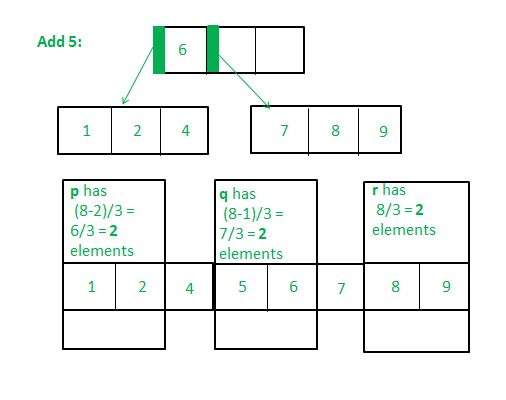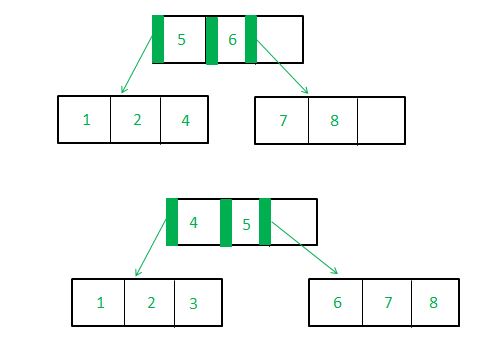El árbol B* de orden m es un árbol de búsqueda que está vacío o que cumple tres propiedades:
- El Node raíz tiene un mínimo de dos y un máximo de 2 pisos ((2m-2)/3) +1 hijos
- Otros Nodes internos tienen el piso mínimo ((2m-1)/3) y máximo m niños
- Todos los Nodes externos están en el mismo nivel.
La ventaja de usar árboles B* sobre árboles B es una característica única llamada división ‘dos a tres’. Por esto, el número mínimo de claves en cada Node no es la mitad del número máximo, sino dos tercios, lo que hace que los datos sean mucho más compactos. Sin embargo, la desventaja de esto es una operación de borrado compleja.
Las dificultades para implementar en la práctica un algoritmo B-star contribuyen a que no se use con tanta regularidad como sus contrapartes B y B+.
A continuación se muestra una implementación básica de la función de inserción de estrella B, solo para demostrar su contraste con B (la implementación completa sería mucho más larga y compleja).
Las partes únicas del algoritmo para la inserción del árbol B* son las siguientes:
División dos-tres
1. Si se inserta en un Node hoja completo (que no es la raíz) y que tiene un hermano derecho completo (y cuyo padre tiene al menos una clave libre):
- Tome una array (‘marray’) que consta de las claves ‘m-1’ del Node hoja completo, la clave principal de este Node, la nueva clave que se insertará y las claves ‘m-1’ de su hermano derecho ( Totalmente m-1 + 1 + 1 + m-1 = 2m llaves)
- Ordenar estas claves
- Cree tres nuevos Nodes:
- p – cuyas claves son los primeros (2m – 2)/3 elementos de ‘marray’
El elemento en el índice (2m – 2)/3 se almacena como ‘parent1’ - q – cuyas claves son los siguientes (2m – 1)/3 elementos de ‘marray’ después de parent1
El elemento en el índice (4m)/3 se almacena como ‘parent2’ - r – cuyas claves son los últimos (2m)/3 elementos de ‘marray’ después de parent2
- p – cuyas claves son los primeros (2m – 2)/3 elementos de ‘marray’
- La clave en el padre de la hoja que apunta a esta hoja debe tener su valor reemplazado como ‘padre1’
- Si la clave principal en iv) tiene claves adyacentes, se deben desplazar hacia la derecha. En el espacio que queda, coloque ‘parent2’.
- p, q y r deben convertirse en claves secundarias de parent1 y parent2 (si ‘parent1’ y ‘parent2’ son las dos primeras claves en el Node principal), de lo contrario, p, q, r deben convertirse en claves secundarias de la clave anterior padre 1, padre 1 y padre 2 respectivamente.
Antes de la inserción:

Después de la inserción:

2. Si se inserta en un Node hoja completo (que no es la raíz) con hermano derecho vacío/no completo.

3. Los otros casos son los mismos que para B-Trees.
Ejemplos:
Entrada: Sume 4 a 1 2 3 L 5 R 7 8 9
Salida: 1 2 L 3 7 R 4 5 R 8 9
3 y 7 se convierten en las claves principales por la división dos-tresEntrada: sume 5 a 2 3 4 L 6 R 8 9 11
Salida: 2 3 L 4 8 R 5 6 R 9 11
3 y 6 se convierten en las claves principales mediante la división dos-tres
A continuación se muestra la implementación del enfoque anterior:
// CPP program to implement B* tree
#include <bits/stdc++.h>
using namespace std;
// This can be changed to any value -
// it is the order of the B* Tree
#define N 4
struct node {
// key of N-1 nodes
int key[N - 1];
// Child array of 'N' length
struct node* child[N];
// To state whether a leaf or not; if node
// is a leaf, isleaf=1 else isleaf=0
int isleaf;
// Counts the number of filled keys in a node
int n;
// Keeps track of the parent node
struct node* parent;
};
// This function searches for the leaf
// into which to insert element 'k'
struct node* searchforleaf(struct node* root, int k,
struct node* parent, int chindex)
{
if (root) {
// If the passed root is a leaf node, then
// k can be inserted in this node itself
if (root->isleaf == 1)
return root;
// If the passed root is not a leaf node,
// implying there are one or more children
else {
int i;
/*If passed root's initial key is itself g
reater than the element to be inserted,
we need to insert to a new leaf left of the root*/
if (k < root->key[0])
root = searchforleaf(root->child[0], k, root, 0);
else
{
// Find the first key whose value is greater
// than the insertion value
// and insert into child of that key
for (i = 0; i < root->n; i++)
if (root->key[i] > k)
root = searchforleaf(root->child[i], k, root, i);
// If all the keys are less than the insertion
// key value, insert to the right of last key
if (root->key[i - 1] < k)
root = searchforleaf(root->child[i], k, root, i);
}
}
}
else {
// If the passed root is NULL (there is no such
// child node to search), then create a new leaf
// node in that location
struct node* newleaf = new struct node;
newleaf->isleaf = 1;
newleaf->n = 0;
parent->child[chindex] = newleaf;
newleaf->parent = parent;
return newleaf;
}
}
struct node* insert(struct node* root, int k)
{
if (root) {
struct node* p = searchforleaf(root, k, NULL, 0);
struct node* q = NULL;
int e = k;
// If the leaf node is empty, simply
// add the element and return
for (int e = k; p; p = p->parent) {
if (p->n == 0) {
p->key[0] = e;
p->n = 1;
return root;
}
// If number of filled keys is less than maximum
if (p->n < N - 1) {
int i;
for (i = 0; i < p->n; i++) {
if (p->key[i] > e) {
for (int j = p->n - 1; j >= i; j--)
p->key[j + 1] = p->key[j];
break;
}
}
p->key[i] = e;
p->n = p->n + 1;
return root;
}
// If number of filled keys is equal to maximum
// and it's not root and there is space in the parent
if (p->n == N - 1 && p->parent && p->parent->n < N) {
int m;
for (int i = 0; i < p->parent->n; i++)
if (p->parent->child[i] == p) {
m = i;
break;
}
// If right sibling is possible
if (m + 1 <= N - 1)
{
// q is the right sibling
q = p->parent->child[m + 1];
if (q) {
// If right sibling is full
if (q->n == N - 1) {
struct node* r = new struct node;
int* z = new int[((2 * N) / 3)];
int parent1, parent2;
int* marray = new int[2 * N];
int i;
for (i = 0; i < p->n; i++)
marray[i] = p->key[i];
int fege = i;
marray[i] = e;
marray[i + 1] = p->parent->key[m];
for (int j = i + 2; j < ((i + 2) + (q->n)); j++)
marray[j] = q->key[j - (i + 2)];
// marray=bubblesort(marray, 2*N)
// a more rigorous implementation will
// sort these elements
// Put first (2*N-2)/3 elements into keys of p
for (int i = 0; i < (2 * N - 2) / 3; i++)
p->key[i] = marray[i];
parent1 = marray[(2 * N - 2) / 3];
// Put next (2*N-1)/3 elements into keys of q
for (int j = ((2 * N - 2) / 3) + 1; j < (4 * N) / 3; j++)
q->key[j - ((2 * N - 2) / 3 + 1)] = marray[j];
parent2 = marray[(4 * N) / 3];
// Put last (2*N)/3 elements into keys of r
for (int f = ((4 * N) / 3 + 1); f < 2 * N; f++)
r->key[f - ((4 * N) / 3 + 1)] = marray[f];
// Because m=0 and m=1 are children of the same key,
// a special case is made for them
if (m == 0 || m == 1) {
p->parent->key[0] = parent1;
p->parent->key[1] = parent2;
p->parent->child[0] = p;
p->parent->child[1] = q;
p->parent->child[2] = r;
return root;
}
else {
p->parent->key[m - 1] = parent1;
p->parent->key[m] = parent2;
p->parent->child[m - 1] = p;
p->parent->child[m] = q;
p->parent->child[m + 1] = r;
return root;
}
}
}
else // If right sibling is not full
{
int put;
if (m == 0 || m == 1)
put = p->parent->key[0];
else
put = p->parent->key[m - 1];
for (int j = (q->n) - 1; j >= 1; j--)
q->key[j + 1] = q->key[j];
q->key[0] = put;
p->parent->key[m == 0 ? m : m - 1] = p->key[p->n - 1];
}
}
}
}
/*Cases of root splitting, etc. are omitted
as this implementation is just to demonstrate
the two-three split operation*/
}
else
{
// Create new node if root is NULL
struct node* root = new struct node;
root->key[0] = k;
root->isleaf = 1;
root->n = 1;
root->parent = NULL;
}
}
// Driver code
int main()
{
/* Consider the following tree that has been obtained
from some root split:
6
/ \
1 2 4 7 8 9
We wish to add 5. This makes the B*-tree:
4 7
/ \ \
1 2 5 6 8 9
Contrast this with the equivalent B-tree, in which
some nodes are less than half full
4 6
/ \ \
1 2 5 7 8 9
*/
// Start with an empty root
struct node* root = NULL;
// Insert 6
root = insert(root, 6);
// Insert 1, 2, 4 to the left of 6
root->child[0] = insert(root->child[0], 1);
root->child[0] = insert(root->child[0], 2);
root->child[0] = insert(root->child[0], 4);
root->child[0]->parent = root;
// Insert 7, 8, 9 to the right of 6
root->child[1] = insert(root->child[1], 7);
root->child[1] = insert(root->child[1], 8);
root->child[1] = insert(root->child[1], 9);
root->child[1]->parent = root;
cout << "Original tree: " << endl;
for (int i = 0; i < root->n; i++)
cout << root->key[i] << " ";
cout << endl;
for (int i = 0; i < 2; i++) {
cout << root->child[i]->key[0] << " ";
cout << root->child[i]->key[1] << " ";
cout << root->child[i]->key[2] << " ";
}
cout << endl;
cout << "After adding 5: " << endl;
// Inserting element '5':
root->child[0] = insert(root->child[0], 5);
// Printing nodes
for (int i = 0; i <= root->n; i++)
cout << root->key[i] << " ";
cout << endl;
for (int i = 0; i < N - 1; i++) {
cout << root->child[i]->key[0] << " ";
cout << root->child[i]->key[1] << " ";
}
return 0;
}
Producción:
Original Tree: 6 1 2 4 7 8 9 After adding 5: 4 7 1 2 5 6 8 9
Publicación traducida automáticamente
Artículo escrito por RenukaNarayanan y traducido por Barcelona Geeks. The original can be accessed here. Licence: CCBY-SA